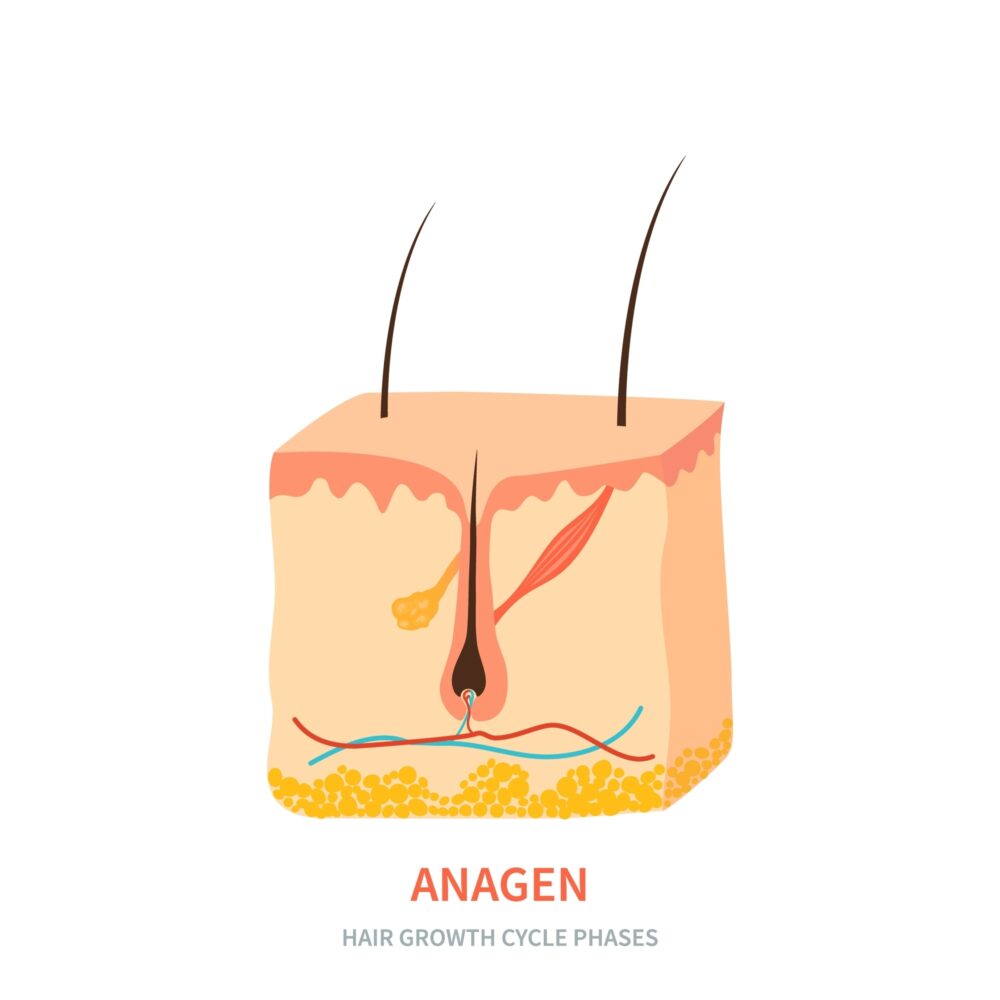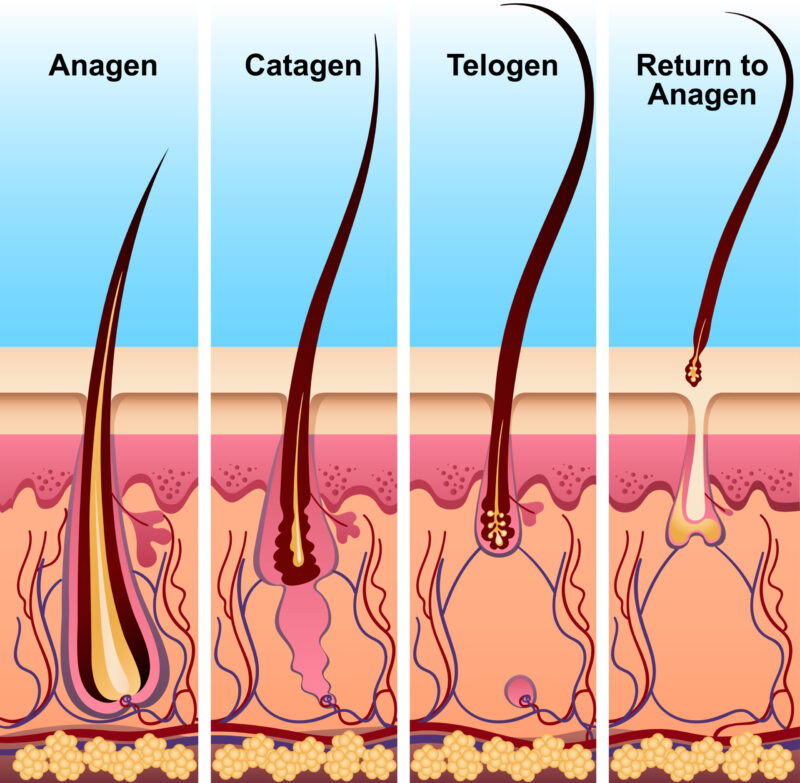Did you know that a single hair follicle can churn out up to 6 inches per year during the anagen phase of hair growth? Theoretically, a 5-year anagen could produce a 30-inch mane. The amazing fact is that up to 90% of your hair is in this growth spurt at any given time, and it can last anywhere from 2 to 7 years depending on genetics, health, and a sprinkle of luck.
The longer the anagen phase, the longer and lusher your hair can get. Intrigued? You should be, because understanding this phase could unlock the secret to thicker, healthier hair.
What Happens During the Anagen Phase?
Scientists estimate that the human scalp hosts 100,000 follicles, each cycling through anagen independently, yet only a tiny fraction ever max out that potential. The anagen phase of hair growth is the unsung hero of your hair’s life story—a dynamic, bustling period where your locks actually grow and thrive.
During this period, hair bulbs divide at a mind-boggling rate, pushing out strands at roughly 1 centimeter per month(that’s about 0.04 inches).
Hair Follicle During the Anagen Phase
Fueled by a rich blood supply, a hair follicle at anagen is a microscopic marvel, constructing hair strands from keratin at a rate of 0.3 to 0.4 millimeters daily. The follicle’s deepest layer, the hair bulb, buzzes as cells divide roughly every 23 to 72 hours.
A healthy follicle can keep this up for 2 to 7 years, but throw in poor nutrition or a hormonal curveball, and it might clock out early. Scientists say this phase accounts for 85-90% of hair’s total life cycle, yet it’s so fragile that even a bout of stress could trigger an exodus to the next phase.
After the Anagen Phase
Once the anagen phase curtains close, enters the catagen phase, a 2-3 week intermission where growth screeches to a halt, and the follicle shrinks to about one-sixth of its size, detaching from its blood supply.
- Catagen Phase: this transitional period affects only 1-3% of your scalp’s 100,000 follicles at any moment, but it’s a critical pivot.
- Telogen Phase: after catagen comes telogen, the resting phase, where the hair strand chills for 2-4 months. Up to 10-15% of your hair is in this stage at any given time, shedding at a rate of 50-100 strands daily.
Seasonal shifts can nudge more hairs into telogen, with scientific studies hinting at a 10% uptick in resting follicles by late summer.
What Can Shorten the Anagen Phase?
The anagen phase is your hair’s prime growth period, but it’s easily derailed. Here’s what can disrupt it and cut it short:
- Stress: Cortisol spikes can push up to 30% of follicles into telogen early, linked to telogen effluvium.
- Poor Nutrition: Lack of protein, iron, or vitamins like D and B12 starves follicles, potentially shortening anagen by months.
- Hormonal Changes: Thyroid issues or postpartum shifts can shrink this phase, with some losing 50% of hair volume post-pregnancy.
- Genetics & Environment: Your 2-7 year baseline can erode 10-15% from UV rays or pollution exposure.
- Medications: Chemo can trigger anagen effluvium, stopping growth in 80-90% of cases within weeks.
Is Your Anagen Hair Phase Long or Short?
The length of your anagen phase—your hair’s growth sweet spot—varies wildly based on factors like genetics, health, and lifestyle. Here’s a table to help you gauge whether yours leans long or short:
Factor | Signs of a Long Anagen Phase | Signs of a Short Anagen Phase |
Hair Length | Hair grows past shoulders or waist (e.g., 24+ inches) | Hair struggles to grow beyond a few inches |
Growth Duration | Anagen lasts 5-7 years, per genetic potential | Anagen lasts 2-3 years or less |
Family History | Relatives have long, thick hair | Relatives have shorter, thinner hair |
Health & Nutrition | Balanced diet rich in protein, iron, vitamins | Deficiencies (e.g., low iron, vitamin D) |
Stress Levels | Low stress, minimal shedding | High stress, noticeable hair loss |
Hormonal Balance | Stable hormones (e.g., normal thyroid function) | Imbalances (e.g., postpartum, thyroid issues) |
Scalp Condition | Healthy scalp, no irritation or damage | Scalp issues (e.g., inflammation, UV overexposure) |
If your hair grows long and strong with few setbacks, you’re likely rocking a lengthy anagen phase. Struggling with slow growth or shedding? It might be on the shorter side.
Dr. Serkan Aygin’s Tips on How to Increase the Anagen Phase of Hair
Dr. Serkan Aygin, awarded ‘Best Hair Doctor in Europe’ (Paris, 2019), has dedicated over 25 years to researching how to increase the anagen phase of hair growth. Dr. Aygin’s work focuses on extending this critical period, helping patients combat hair loss and boost growth naturally:
- Low-Level Laser Therapy (LLLT): LLLT uses red light (800-860 nm) to penetrate the scalp, boosting cellular energy (ATP) and blood flow. This stimulates follicles to stay in anagen longer and speeds regrowth, with studies showing a 35% hair growth increase in 16 weeks.
- Platelet-Rich Plasma (PRP): PRP injects your own growth-factor-rich plasma into the scalp, nourishing follicles and extending anagen by promoting cell repair and angiogenesis. Dr. Aygin reports a 98% regrowth rate when paired with his transplant techniques.
- Mesotherapy: This delivers a custom cocktail of vitamins, minerals, and meds (like minoxidil) directly to follicles via micro-injections. It enhances scalp circulation and nutrient supply, prolonging anagen and strengthening hair.
- Stem Cell Therapy: Using mesenchymal stem cells or exosomes, this regenerative approach rejuvenates dormant follicles, pushing them back into anagen.
- MD Bio Plus Hair Complex: This natural line featuring shampoos, serums, and supplements with Capixyl, Redensyl, and Biotin, feeds follicles with clinically proven ingredients. It supports anagen by reducing loss and enhancing strand resilience.
- Natural Nutritional Support: Aygin emphasizes diet’s role—protein, iron, and vitamins (D, B12)—to fuel follicle health. A nourished scalp sustains anagen longer, preventing early shutdown from deficiencies.
Dr. Aygin blends these therapies with hair transplant techniques like Sapphire FUE and DHI, achieving natural results in 6-12 months.
Global Innovations in Extending the Anagen Phase of Hair Growth
As the anagen phase dictates hair length and density, researchers are zeroing in on ways to prolong it, tapping into cutting-edge science to keep follicles thriving. Here are three standout discoveries from recent global efforts as of March 28, 2025:
- MCL-1 Protein’s Hair-Growth Boost: In a breakthrough from WEHI (Australia) and Duke-NUS Medical School (Singapore), scientists uncovered that the protein MCL-1, typically known for cell survival, also sustains the anagen phase. Published inNature Communications on March 25, 2025, their study shows MCL-1 prevents follicles from slipping into the resting phase too soon, with lab tests hinting at a 20-30% longer growth cycle in animal models.
- 2-Deoxy-D-Ribose Stimulates Anagen: A 2025 study inFrontiers in Pharmacology explored how 2-deoxy-D-ribose, a sugar derivative, revs up the anagen phase in androgenic alopecia models. Researchers found it boosts blood vessel growth around follicles, enhancing nutrient delivery and extending anagen by up to 15% in mice.
- Polygonum Multiflorum’s Natural Power: From South Korea, a 2020 study (still influencing 2025 research) inBMC Complementary Medicine and Therapies showed Polygonum multiflorum extract elongates anagen in human dermal papilla cells by upping anti-apoptotic Bcl2 and slashing catagen-trigger Dkk-1. Recent follow-ups suggest a 25% anagen extension in organ-cultured human follicles, with ongoing trials refining this botanical extract into a scalable treatment.
What May Go Wrong During the Anagen Stage?
The anagen phase is hair’s growth powerhouse, but it’s not bulletproof—disruptions can trigger dramatic fallout. Here’s the rundown:
1. Anagen Effluvium
Anagen effluvium—a condition where this phase gets rudely interrupted—can lead to sudden, dramatic hair loss, affecting thousands of people yearly.
What Causes Anagen Effluvium?
Chemotherapy, radiation, or toxins (e.g., heavy metals) slam the brakes on rapid cell division, shedding hair within days to weeks.
2. Telogen Effluvium
Excessive shedding (50-100+ strands daily) as follicles jump early from anagen to the resting telogen phase, affecting up to 30% of hair.
What Causes Telogen Effluvium?
Stress, hormonal shifts (e.g., postpartum), nutritional gaps (iron, protein), or illness (e.g., fever) push follicles out of growth mode.
Diagnosis and Treatment of both Anagen and Telogen Effluvium
- Diagnosis: Doctors use patient history, scalp exams, and pull tests; biopsies confirm anagen vs. telogen. Bear in mind: Serkan Aygin offers free online medical consultations to patients worldwide.
- Treatment: Anagen effluvium often reverses post-toxin (e.g., chemo ends); telogen effluvium needs root-cause fixes—stress relief, diet tweaks, or minoxidil to nudge follicles back to anagen fast.
FAQs
How do I know if my hair is in anagen phase?
During anagen hair grows steadily (1 cm/month), looks thick, and resists gentle pulling—up to 90% of your scalp hair is typically anagen.
How to keep your hair in anagen phase?
Eat protein-rich foods, manage stress, use minoxidil, and try PRP or LLLT to extend growth.
What are the 4 stages of hair growth?
Anagen (growth), catagen (transition), telogen (resting), and exogen (shedding)—a cycle repeating over years.
What is the difference between anagen and telogen?
Anagen is active growth (2-7 years); telogen is resting (2-4 months) before shedding.


